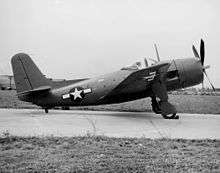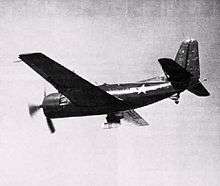Curtiss XBT2C
The Curtiss XBT2C was an experimental single-engined dive/torpedo bomber developed during World War II.
| XBT2C | |
|---|---|
 | |
| The XBT2C-1 | |
| Role | Attack aircraft |
| National origin | United States |
| Manufacturer | Curtiss Aeroplane and Motor Company |
| First flight | March 1945 |
| Number built | 9 |
| Developed from | Curtiss XBTC |
Development
It was based on the Curtiss XBTC single-seat dive/torpedo bomber, but used the less powerful Wright R-3350 radial engine, and could carry a second crew member in the rear fuselage. It was fitted with radar, which was carried in a pod under the starboard wing. Nine of ten projected aircraft were built. They were Curtiss' last type for the U.S. Navy. All were scrapped in the late 1940s.[1]
Specifications (XBT2C-1)


Data from Jane's all the World's Aircraft 1947[2]Curtiss Aircraft 1907–1947[3]
General characteristics
- Crew: 2
- Length: 39 ft 2 in (11.94 m)
- Wingspan: 47 ft 7.09375 in (14.5057813 m)
- Width: 22 ft 6.5 in (6.871 m) wings folded
- Height: 12 ft 1 in (3.68 m)
- Height wings folded: 16 ft 7.8125 in (5.075238 m)
- Maximum height during folding: 20 ft 6.625 in (6.26428 m)
- Wing area: 416 sq ft (38.6 m2)
- Airfoil: root: NACA 23017 mod. ; tip : NACA 23009[4]
- Empty weight: 12,268 lb (5,565 kg)
- Gross weight: 19,022 lb (8,628 kg)
- Powerplant: 1 × Wright R-3350-24 Duplex-Cyclone 18-cylinder air-cooled radial piston engine, 2,500 hp (1,900 kW)
- Propellers: 4-bladed Hamilton Standard 6559A-18, 13 ft 8 in (4.17 m) diameter constant-speed propeller
Performance
- Maximum speed: 297 mph (478 km/h, 258 kn) at sea level
- 330 mph (290 kn; 530 km/h) at 17,000 ft (5,200 m)
- Range: 1,310 mi (2,110 km, 1,140 nmi)
- Service ceiling: 26,300 ft (8,000 m)
- Rate of climb: 1,890 ft/min (9.6 m/s)
Armament
- Guns: 2x 20 mm (0.787 in) AN/M2 cannon
- Rockets: 8x 5 in (130 mm) rockets under wing
- Bombs: 1x 2,000 lb (910 kg) or 2x 500 lb (230 kg) or 4x 250 lb (110 kg) or torpedo in 14 ft 3 in (4.34 m) long internal bomb-bay
Avionics
Search radar under starboard wing
See also
Related development
Aircraft of comparable role, configuration and era
- Douglas AD Skyraider
- Martin AM Mauler
- Kaiser-Fleetwings XBTK
Related lists
Notes
- U.S. Naval Aviation News September 1979, pp.20–21
- Bridgman, Leonard, ed. (1947). Jane's all the World's Aircraft 1947. London: Sampson Low, Marston & Co. pp. 212c–213c.
- Bowers, Peter M. (1979). Curtiss aircraft, 1907-1947. London: Putnam. pp. 449–450. ISBN 0370100298.
- Lednicer, David. "The Incomplete Guide to Airfoil Usage". m-selig.ae.illinois.edu. Retrieved 16 April 2019.
References
- Bowers, Peter M. (1979). Curtiss Aircraft 1907–1947. London: Putnam. ISBN 0-370-10029-8.
- Donald, David (1997). The Complete Encyclopedia of World Aircraft. New York: Barnes & Noble. ISBN 0-7607-0592-5.
- Thomason, Tommy H. (2009). Strike from the Sea: U.S. Navy Attack Aircraft From Skyraider to Super Hornet 1948–Present. North Branch, Minnesota: Specialty Press. ISBN 978-1-58007-132-1.
External links
![]()